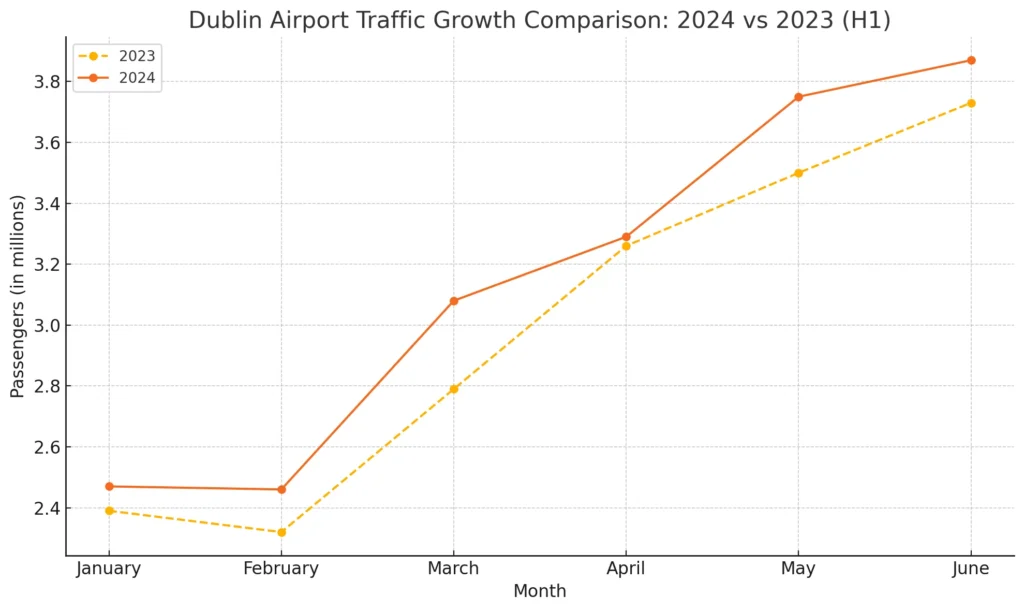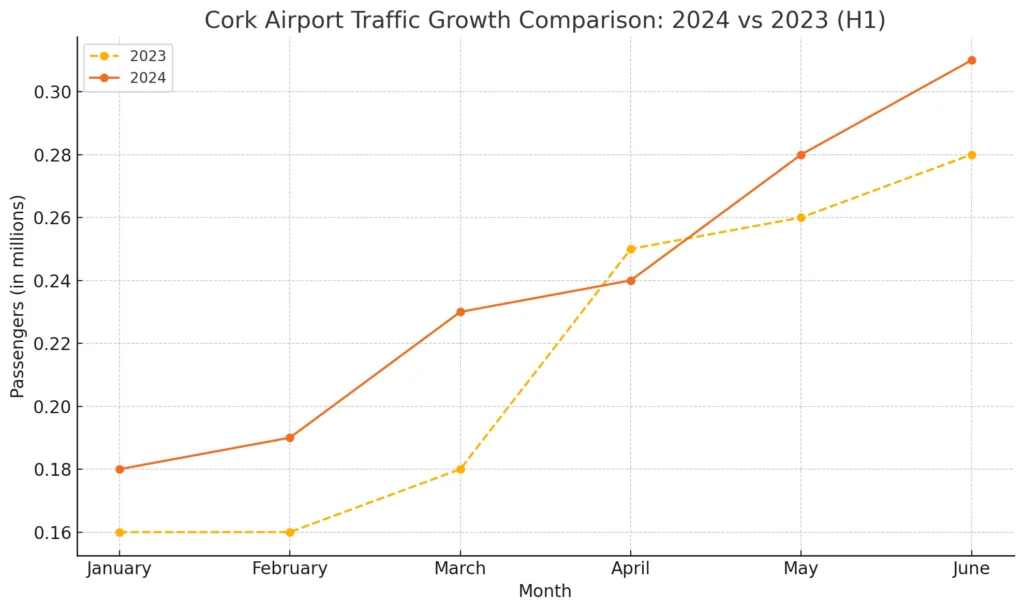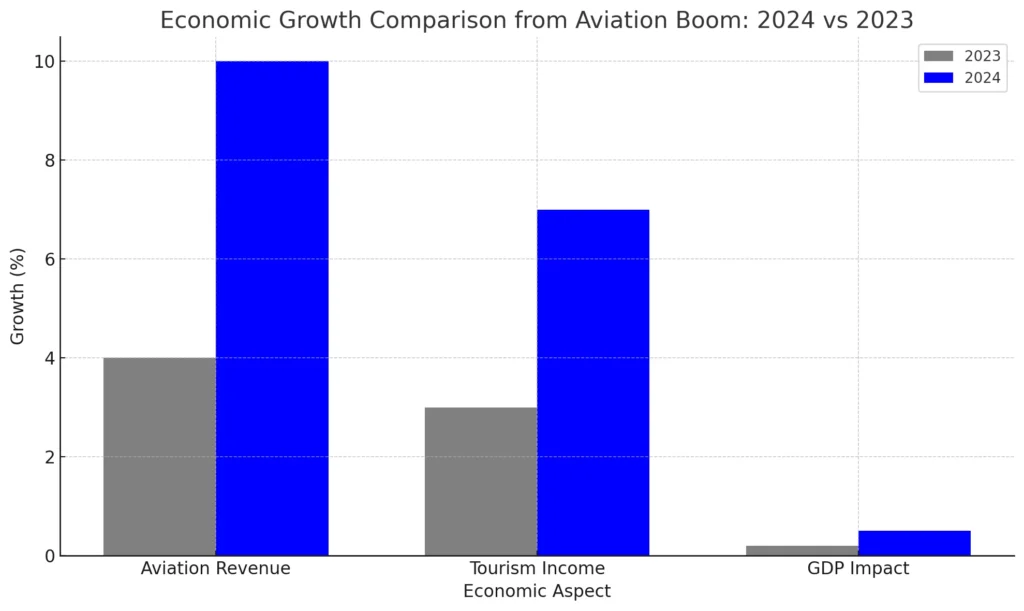The latest passenger news highlights significant growth in Ireland’s air travel sector, especially through Dublin and Cork airports. In the first half of 2024, these two major airports saw a combined total of 18 million passengers. This reflects a strong recovery in travel demand and showcases the continued importance of these airports to Ireland’s economy. Dublin and Cork’s growth trends provide insights into the dynamics of post-pandemic travel and the potential challenges of future expansion.
Dublin Airport Passenger Surge
Dublin Airport’s Traffic Increase

Dublin Airport, as the largest airport in Ireland, witnessed a notable increase in passenger traffic during the first six months of 2024. The airport handled over 13 million passengers, a 5% increase compared to the same period in 2023. This growth marks a robust recovery in international travel, with Dublin serving as a critical hub for both European and transatlantic flights. The surge reflects broader global trends as tourism rebounds and travelers regain confidence.
Increased passenger numbers were driven by rising international connections and new routes established by major airlines. Dublin’s strategic location as a gateway between North America and Europe has further enhanced its appeal for both business and leisure travelers. With the tourism sector showing signs of recovery, the airport’s increased traffic indicates a positive trend for Ireland’s travel and hospitality industries.
Factors Behind Dublin’s 5% Growth
Several factors contributed to Dublin Airport’s 5% growth in the first half of 2024. The expansion of flight routes, including new connections to North American and European destinations, played a key role. Airlines added more frequent flights to meet the growing demand, boosting Dublin’s connectivity.
Additionally, the Irish government’s initiatives to support tourism, such as marketing campaigns and relaxed travel restrictions, have been instrumental. The global increase in post-pandemic travel, along with improved passenger services and infrastructure at Dublin Airport, has made it a preferred choice for travelers. These elements combined have made Dublin a focal point in passenger news, highlighting its ongoing recovery and growth trajectory.
Cork Airport: The Fastest-Growing Airport in Ireland
11% Rise in Cork’s Passenger Numbers

Cork Airport emerged as Ireland’s fastest-growing airport during the first half of 2024. With an 11% increase in passenger numbers compared to the previous year, Cork handled approximately 5 million passengers. This surge reflects Cork’s strategic importance in the region and its ability to attract a diverse range of travelers.
The airport’s growth was fueled by the addition of new routes and increased frequency of flights to popular destinations in Europe. Enhanced partnerships with airlines, alongside marketing efforts targeting inbound tourism, have helped position Cork as a key gateway for the south of Ireland. The rise in passenger traffic is a testament to Cork’s potential for future expansion in the Irish aviation market.
Cork’s Role in Ireland’s Aviation Sector
Cork Airport plays a crucial role in Ireland’s aviation sector, serving as a regional hub that supports both international and domestic travel. Its strategic location makes it a convenient option for travelers heading to the scenic south and west of Ireland. The airport has become a focal point for regional tourism, contributing significantly to the local economy through increased visitor spending.
The growth of Cork Airport is also essential for balancing air traffic across Ireland, especially as Dublin Airport faces capacity constraints. Cork’s ability to attract more passengers helps alleviate pressure on Dublin, creating a more distributed air travel network across the country. This dynamic contributes to the overall health of the aviation industry in Ireland.
Economic Impact of Passenger Growth

Revenue Increase from Domestic Travel
The rise in passenger numbers at both Dublin and Cork airports has had a significant economic impact, particularly in terms of increased revenues from domestic travel. The surge in domestic flights has contributed to the economic recovery of regional hubs, allowing for better connectivity within Ireland.
This boost in passenger news has translated into higher revenues from aeronautical activities, such as landing fees and passenger charges. The demand for domestic flights has also supported the growth of regional airports, providing new opportunities for local businesses and tourism operators. As travel demand continues to rise, the economic benefits are likely to extend beyond the airports, contributing to Ireland’s overall economic recovery.
Rise in Aeronautical and Non-Aeronautical Revenues
Beyond direct passenger charges, Dublin and Cork airports have seen increased revenue from non-aeronautical sources, such as retail, dining, and car rentals. This diversification of income has been crucial in offsetting some of the financial challenges faced by the aviation industry during the pandemic.
Retail and hospitality services within the airports have benefited from the increased foot traffic. Shops, restaurants, and lounges have seen a revival, with travelers spending more time and money within the airport terminals. This revenue stream is essential for the financial sustainability of the airports, allowing them to reinvest in infrastructure improvements and service enhancements.
Challenges and Future Outlook
Impact of Dublin Airport’s Passenger Cap
Despite the positive growth, Dublin Airport faces challenges due to its passenger cap, which limits the number of passengers the airport can handle annually. This restriction has been a subject of debate, as it could potentially hinder the airport’s ability to keep up with rising demand. With the recent surge in passenger numbers, Dublin is approaching its cap, leading to concerns about congestion and delays.
The passenger cap is meant to manage noise and environmental impacts on surrounding communities, but it also places pressure on the airport to optimize its operations within these limits. Balancing growth with sustainability is crucial, as further expansion may require significant investment in infrastructure and negotiations with stakeholders.
Plans for Expanding Capacity
To address these challenges, both Dublin and Cork airports are exploring ways to expand capacity. Dublin Airport has plans to enhance its terminal facilities, improve security checkpoints, and increase the efficiency of baggage handling systems. These upgrades aim to reduce congestion and streamline passenger flow, making the travel experience more seamless.
Cork Airport, on the other hand, is focusing on adding more routes and expanding its reach into new markets. With a strategic emphasis on growth, Cork aims to support the increasing demand for regional travel while complementing Dublin’s role as a major international hub. Together, these plans are set to shape the future of air travel in Ireland, ensuring that both airports can continue to grow sustainably.
Conclusion
The passenger news from Dublin and Cork airports underscores a promising recovery for Ireland’s aviation industry. With a combined total of 18 million passengers in the first half of 2024, these airports are proving their resilience and adaptability in the face of changing travel trends. Dublin’s position as a gateway to Europe and North America, alongside Cork’s rapid growth as a regional hub, showcases a balanced approach to handling increased travel demand. While challenges remain, including capacity constraints and environmental considerations, both airports are well-positioned to capitalize on future opportunities.







